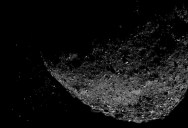Newly Discovered Asteroid Might Contain The Rarest Precious Metal Ever Found And Unknown Natural Elements

If you’ve gotten a standard education anytime in the past 50 years, there’s a good chance you not only are aware of the periodic table of elements, but you might even have memorized some of it.
Most of us, though, never really go into depth about each little square and the element it represents.
Come with us on a little bit deeper of a dive, and why the extreme density of some asteroids could mean they’re made of an element we’ve yet to add.
Osmium, in case you’re wondering, is the most dense naturally occurring and stable element on Earth.
Recently, a team of University of Arizona physicists wondered whether or not Compact Ultradense Objects (CUDOs) could have even greater mass density.
“In particular, some observed asteroids surpass this mass density threshold. Especially noteworthy is the asteroid 33 Polyhymnia, since the mass density of asteroid 33 Polyhymnia is far greater than the maximum mass density of familiar atomic matter, it can be classified as a CUDO with an unknown composition.”
Though Osmium is the densest stable element, researchers have produced elements with higher atomic numbers in experiments.
Oganesson is the densest element in the periodic table, but is unstable, radioactive, and has a super short half-life.
Theories abound about elements beyond the periodic table, and this research team used the relativistic Thomas-Fermi model of the atom to estimate the mass density of elements much higher in density even than Oganesson.
They could not find any elements with high enough mass densities to explain the makeup of asteroid 33 Polyhymnia.
“However, elements in the other theoretical island of nuclear stability near Z=164, which we predict to populate mass density values between 36.0 and 68.4 c/cm3, which are reasonable candidates. If some significant part of the asteroid were made of these superheavy metals, it is plausible that the higher mass density could be near the experimentally measured value.”

This is interesting to anyone just kind of interested in this sort of science, but also to anyone thinking about potential mining in space.
“All super-heavy elements – those that are highly unstable as well as those that are simply unobserved – have been lumped together as ‘unobtainium.’ The idea that some of these might be stable enough to be obtained from within our Solar System is an exciting one.”
Follow the money, they say.
Or in this case, the superheavy asteroid with the nerve to enter our general space area.
If you think that’s impressive, check out this story about a “goldmine” of lithium that was found in the U.S. that could completely change the EV battery game.

Sign up to get our BEST stories of the week straight to your inbox.




